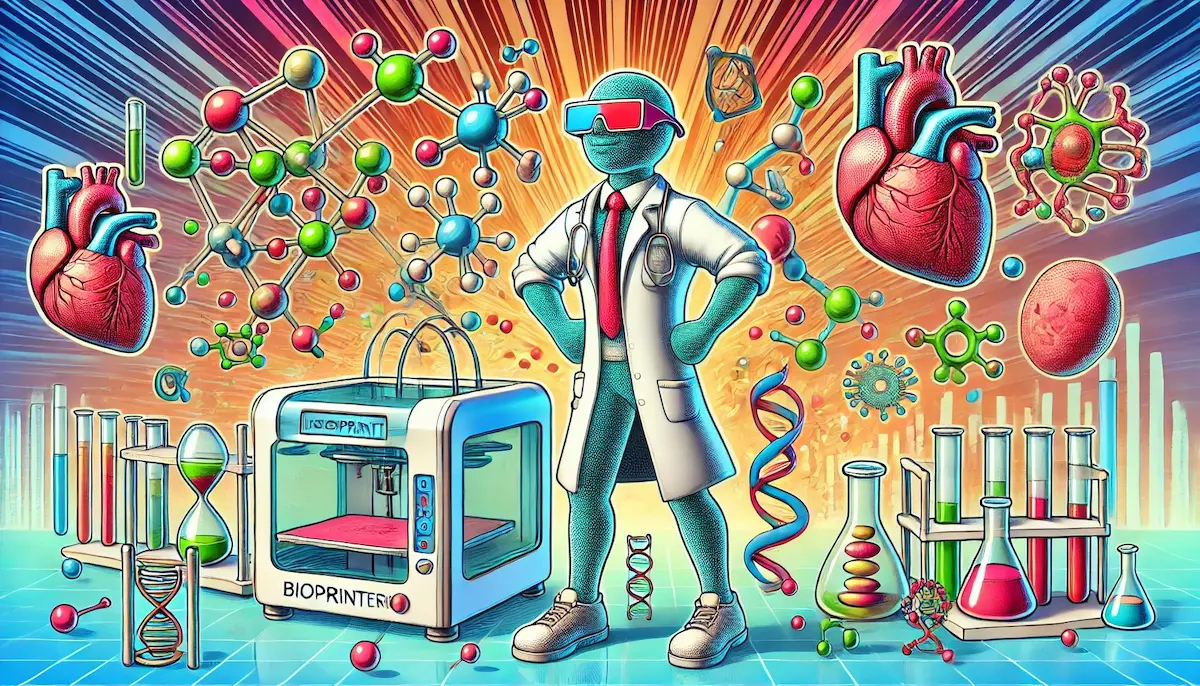Bioprinting is an exciting and rapidly evolving technology that combines biology and 3D printing to create complex tissues and organs. This cutting-edge field holds tremendous promise for regenerative medicine, drug testing, and personalized healthcare. Let’s explore what bioprinting is, how it works, and its potential impact on the future of medicine.
What is Bioprinting?
Bioprinting is the process of using 3D printing technology to fabricate biological tissues and organs. Unlike traditional 3D printing, which uses materials like plastic or metal, bioprinting utilizes bioinks made from living cells, growth factors, and biomaterials. These bioinks are carefully deposited layer by layer to create structures that mimic the natural architecture of human tissues.
How Does Bioprinting Work?
Bioink Preparation
The first step in bioprinting is preparing the bioink. Bioinks are composed of living cells suspended in a biocompatible material, such as hydrogels, which provide the necessary support for cell growth and function. These bioinks can be tailored to include specific cell types, growth factors, and other components needed to replicate the desired tissue.
3D Bioprinter
A 3D bioprinter is a specialized device designed to precisely deposit bioinks in a predefined pattern. Similar to traditional 3D printers, bioprinters follow a digital blueprint or computer-aided design (CAD) model to construct the tissue layer by layer. The printer’s nozzles dispense the bioinks, creating intricate and functional structures.
Layer-by-Layer Printing
Bioprinting involves the precise placement of cells and biomaterials in a layer-by-layer fashion. Each layer is carefully built upon the previous one, allowing for the creation of complex and three-dimensional tissue constructs. Advanced bioprinters can print multiple types of cells and materials simultaneously, enabling the fabrication of heterogeneous tissues with varying properties.
Post-Printing Maturation
Once the bioprinting process is complete, the printed tissue requires a period of maturation. This involves placing the construct in a bioreactor, a controlled environment that provides the necessary conditions for cell growth and differentiation. The bioreactor supplies nutrients, oxygen, and mechanical stimuli to help the printed tissue develop and achieve its intended function.
Applications of Bioprinting
Tissue Engineering and Regenerative Medicine
Bioprinting holds significant potential for tissue engineering and regenerative medicine. It can be used to create skin grafts for burn victims, cartilage for joint repair, and even more complex tissues like liver or heart patches. These bioprinted tissues can be used for transplantation, reducing the need for donor organs and minimizing the risk of rejection.
Drug Testing and Development
Bioprinted tissues provide a more accurate and human-relevant platform for drug testing and development. Pharmaceutical companies can use bioprinted tissues to test the safety and efficacy of new drugs, reducing the reliance on animal models and improving the predictability of clinical outcomes.
Personalized Medicine
In the future, bioprinting could enable personalized medicine by creating patient-specific tissues and organs. By using a patient’s own cells to print tissues, doctors can ensure compatibility and reduce the risk of immune rejection. This approach could revolutionize organ transplantation and provide customized solutions for patients with unique medical needs.
Research and Disease Modeling
Bioprinted tissues offer a valuable tool for studying diseases and understanding their progression. Researchers can create tissue models that mimic specific diseases, allowing for detailed investigation of disease mechanisms and the development of targeted therapies.
Benefits of Bioprinting
Reduced Organ Shortage
Bioprinting has the potential to address the critical shortage of donor organs. By creating tissues and organs in the lab, bioprinting can provide a limitless supply of transplantable tissues, saving countless lives.
Customization and Precision
Bioprinting allows for precise control over the composition and architecture of tissues. This customization ensures that the printed tissues closely mimic the patient’s natural tissues, improving the success of medical treatments.
Ethical and Animal-Free Testing
Bioprinted tissues offer an ethical alternative to animal testing. By using human-relevant models, researchers can obtain more accurate data while reducing the ethical concerns associated with animal experimentation.
Challenges and Future Outlook
While bioprinting holds immense promise, it also faces significant challenges. These include the complexity of creating fully functional organs, ensuring the long-term viability of printed tissues, and overcoming regulatory hurdles. Additionally, the high cost and technical complexity of bioprinting technology are barriers to widespread adoption.
However, ongoing research and technological advancements are rapidly addressing these challenges. As bioprinting techniques continue to improve, the technology is expected to become more accessible and capable of producing increasingly complex and functional tissues.
The future of bioprinting is bright, with the potential to revolutionize healthcare, extend lives, and improve the quality of life for patients around the world. As the field continues to evolve, bioprinting will undoubtedly play a central role in the next generation of medical treatments and innovations.
Blockfine thanks you for reading and hopes you found this article helpful.
